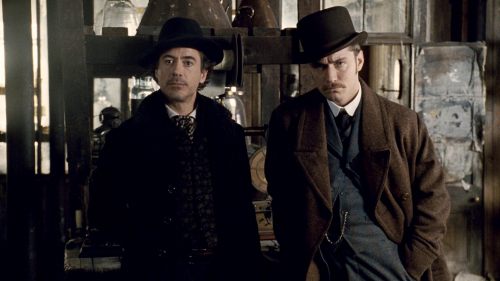The Badass Hall of Fame: Sherlock Holmes
When people think of the character Sherlock Holmes, they probably know that he was a private detective and imagine his smoking out of a curved pipe and saying, “Elementary, my dear Watson,” more times than not. What most people may not know is that those last two things never appear in the original 56 short stories and four novels, written by Sir Arthur Conan Doyle and published 125 years ago. For the rest of the Holmes lore, we have popular culture to thank. Indeed, pop culture continues to inform us about this truly immortal fictional character on a regular basis.
When Conan Doyle first created the character of Sherlock Holmes, he was a young doctor with a not-so-flourishing private practice, and therefore lots of extra time on his hands. Inspired by a doctor with whom he had trained who had the ability to diagnose patients simply by acutely observing them, Doyle took the infant literary genre of detective fiction and created an icon now recognized around the globe. The British became so invested in the character of Holmes that, when Doyle tired of him and tried to kill off his creation in 1893, people dressed in mourning clothes to express their sadness and frustration at losing their hero. After almost a decade’s hiatus, Doyle gave into popular demand and resurrected the astonishingly incisive detective.
Holmes has been the subject of plays, radio shows, films, books, comics and television shows. You can find him battling Nazis in the black and white 1940s Basil Rathbone films; blogging in the newest addition to the Holmes canon, the BBC’s Sherlock series, set in modern day London; Granada Television did a spectacularly true-to-the-original-tales show starring the late, great Jeremy Brett in the 90s; and American actor Robert Downey Jr. can be seen as Holmes in movie theatres worldwide right now. There was the adventures of Young Sherlock Holmes, Holmes battling Jack the Ripper in Murder By Decree and Holmes battling cocaine addiction in The Seven Percent Solution. There's even The Great Mouse Detective. Just what is it about this socially-awkward, hawk-nosed genius that keeps us coming back for more?
Much like a modern comic superhero, the key to Sherlock Holmes is his cut and dried approach to morality: there is good, and there is bad, and Holmes always tries to help out on the side of the good. Most of his cases in the original stories start with someone coming to him for help in a strange situation, often one in which they cannot pay. Holmes takes the case, simply for the pure mental stimulation of solving the mystery and putting his brain to work. Sometimes the police get involved—often times, they merely get in the way of his investigation. Casual readers who think of Holmes as just a machine don’t comprehend the moral and emotional depth of this man who, more often than not, allows the perpetrators to go free if they’ve seen the error of their ways.
Holmes has a classic cast of supporting characters, as well as iconic locations. His trusty sidekick is the ever-patient Dr. John H. Watson, a medical doctor who practiced and was injured during the war (in Afghanistan, something very convenient for the modern BBC version). He and Sherlock become flatmates through coincidence and necessity, but they soon become close friends and professional allies. Watson’s admiration for Holmes’ cleverness knows no bounds, but he is often impatient with the detective’s abruptness and peculiarities. Watson is intelligent, brave, a crack shot and a capable surgeon. He’s been portrayed by dozens of actors, most recently by Jude Law in Guy Ritchie’s films and by Martin Freeman in the BBC Series.
Holmes and sometimes Watson (depending on his state of matrimony) live at the famous address, 221 B Baker Street. Their landlady is the long-suffering Mrs. Hudson. She merely wants the home to be tidy and for Holmes to eat well, and they often find themselves at odds over her fussing. The actual address in London is a bank now, but Baker Street itself is home to a few Sherlock Holmes museums.
Sherlock’s brother, Mycroft Holmes, is another character found rarely in the original canon but quite popular in recent adaptations of the universe. Mycroft is depicted as possessing an intellect equal to and possibly even besting Sherlock’s, but he is ill-suited for detective work, as he is unwilling to put in the time and physical labor necessary. In “The Adventure of the Greek Interpreter,” Holmes describes Mycroft as having no ambition or energy, someone who “would rather be considered wrong than take the trouble to prove himself right.” As a character who must always be considered right, Sherlock cannot understand this quality in his brother.
Sherlock battles his nemesis, “the Napoleon of Crime,” Professor James Moriarty, in just about every current Holmes tale. In the original stories, however, Moriarty only appears twice, an invention created to help Doyle get free of his overbearing fictional character. They battle to the death over Switzerland’s Reichenbach Falls in Doyle’s “The Final Problem,” and it doesn’t end well for the Professor, although Holmes, we know, makes it out okay (retroactively). In the BBC series, Moriarty, played by Andrew Scott, is referred to as a “consulting criminal,” giving his felonious expertise to those in need, in contrast to Sherlock’s singular status as consulting detective.
Another character who is referenced repeatedly is Irene Adler, an American opera singer, and the only woman to ever outwit Sherlock Holmes. As pervasive as she is in Holmes culture—the brilliant, diabolical beauty who keeps Holmes on his toes—it’s easy to forget that she only appears in one original short story (“A Scandal in Bohemia”), and even then, the reader spends very little time with Adler. Her bravada keeps us coming back for more, though—we just can’t get enough of this lady, mostly because we enjoy watching Holmes get the run around. Adler’s been portrayed by Rachel McAdams in the Ritchie films and Lara Pulver in the current BBC series.
The original Holmes novels and short stories boast some brilliant writing, for anyone looking to go beyond the modern-day visual interpretations. Some of Conan Doyle’s sharpest writing can be seen in exchanges like this one, between Holmes and Inspector Gregory, who is assigned to the case of the missing racehorse “Silver Blaze,” as written down by Dr. Watson:
“Colonel Ross still wore an expression which showed the poor opinion which he had formed of my companion’s ability, but I saw by the Inspector’s face that his
attention had been keenly aroused.
‘You consider that to be important?’ he asked.
‘Exceedingly so.’
‘Is there any other point to which you would wish to draw my attention?’
‘To the curious incident of the dog in the night-time.’
‘The dog did nothing in the night-time.’
‘That was the curious incident,’ remarked Sherlock Holmes.”
For those of us intent on knowing way too much about a fictional character, January 6th is generally agreed upon by Holmes scholars as Sherlock Holmes’ birthday, so raise a glass this month! You can also celebrate this January by seeing the second installment in Guy Ritchie’s Sherlock Holmes film franchise (the first Ritchie film, starring Robert Downey Jr. as Holmes and Jude Law as Watson, opened in 2009). While the big-budget Hollywood film is a fairly fun romp, if you’re looking for something a little more intense and well-crafted, the BBC series Sherlock is back for a second season in the UK starting this January as well. Do yourself a favor and watch the first season while it’s streaming on Netflix here in the US—even the most casual Holmes fan won’t be disappointed by the taut writing of confirmed Holmes fanatics Stephen Moffatt and Mark Gatiss (who plays Mycroft in the series), the studied sardonicism of Martin Freeman’s Dr. Watson and the piercing eyes and high cheekbones of Benedict Cumberbatch, who takes on the almost sociopathic persona of the great detective.
Other pressing and current Holmes news is the ongoing battle to save Undershaw, Doyle’s family home. Plans to tear down the building have caused an uproar in Britain, and a concerted effort is being made to save the building and its surrounding property. Anyone interested in preserving this gifted writer’s home can check out the cause here.
The most exciting aspect of the character of Sherlock Holmes is his continued success in capturing the imagination of every generation that comes into contact with him. I became a Holmes fanatic at the age of twelve, when my father bought me my first collection of Sherlock Holmes short stories. How exciting to think of twelve-year-olds today who can still go to the theatre to see films about the same character, and possibly start to read the same stories that influenced me so greatly! When you talk about an enduring, immortal character, there is none greater than the world’s only consulting detective, Sir Arthur Conan Doyle’s Sherlock Holmes.


